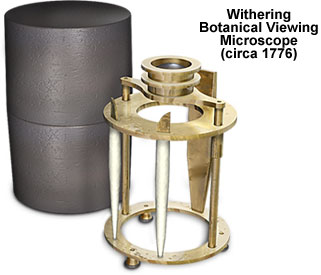Withering Botanical Viewing Microscope
Described and illustrated in the landmark botanical treatise, A Botanical Arrangement of All the Vegetables Naturally Growing in Great Britain (published in 1776), this portable simple botanical microscope was designed by British physician William Withering. Variations on the popular design survived throughout the nineteenth century, including improved models created by Withering, a well-known member of the Lunar Society, who lived in Birmingham, England.

Illustrated above with the black leather storage case, the brass optical field instrument is modeled after the original, which is described and photographed in Gerard Turner's critically acclaimed book, Collecting Microscopes. The single, biconvex lens, which is plagued by chromatic and spherical aberrations, is capable of magnifying specimens between three and five times life-size. A large, round brass stage that features a large circular aperture is designed to support plant specimens. By translating the stage up and down, two support rods enable the naturalist to focus the simple microscope. The circular, brass base features three adjustable brass screws (as feet), and includes neither a substage nor reflector. Illumination of the specimen depends on ambient light.
Accessories include a pair of brass tweezers and ivory-handled pin and scalpel. To focus the original model of the Withering botanical microscope, the accessories have to be removed from their storage locations on the stand. Withering's later versions are more compact and can be stored in pocket-sized wooden boxes that double as microscope bases.
BACK TO EIGHTEENTH CENTURY MICROSCOPES
